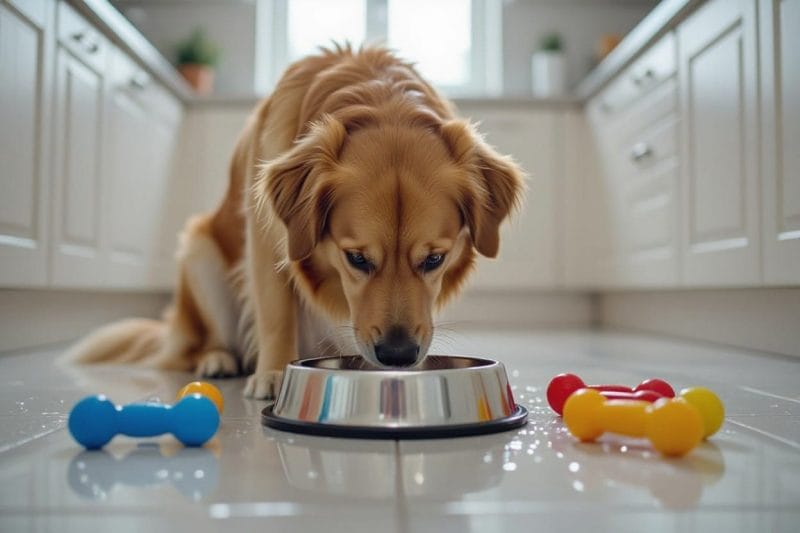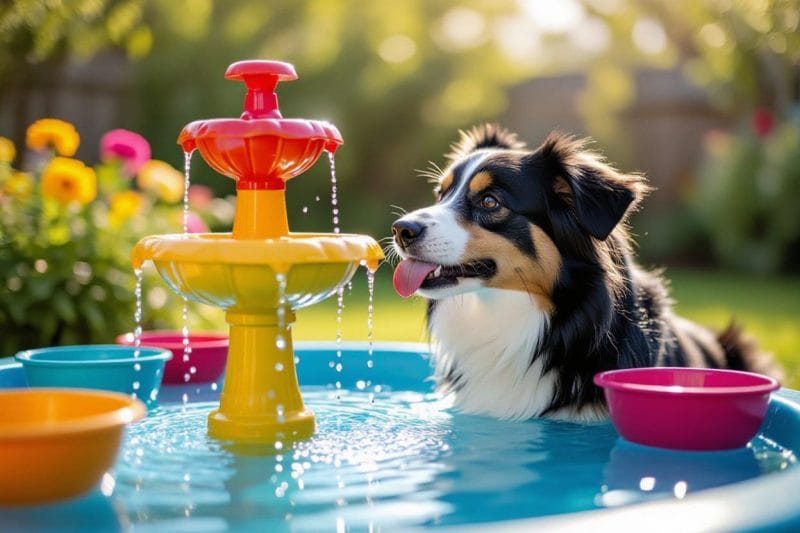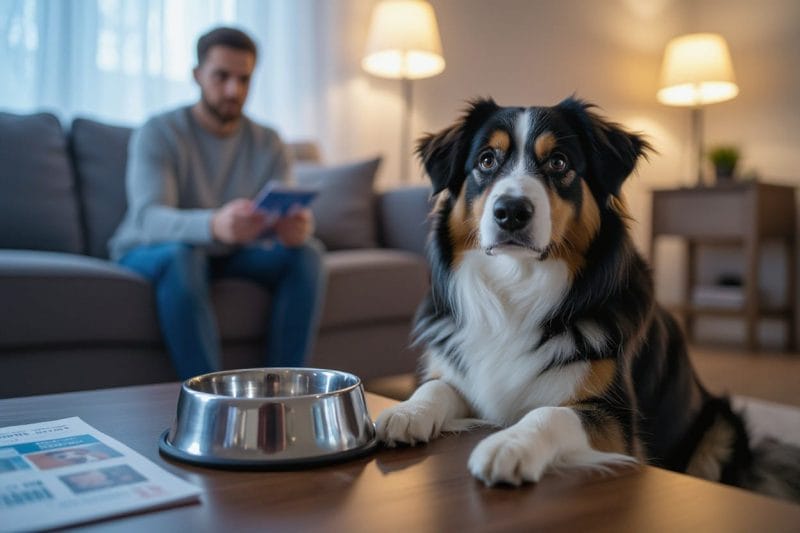There’s nothing more concerning than noticing your dog is not drinking water, as hydration is crucial for their overall health. If your pet suddenly avoids water, you need to understand the potential causes and signs of dehydration. This guide will help you identify reasons why your dog may be refusing water and offer practical solutions to encourage proper hydration, ensuring your furry friend stays healthy and comfortable.
Key Takeaways:
- If a dog is not drinking water, it could indicate underlying health issues such as dental problems, infections, or kidney disease, and should be monitored closely.
- Encouraging hydration can involve offering fresh water frequently, providing wet food, or adding water or broth to regular meals to stimulate intake.
- If a dog refuses to drink water for more than 24 hours, or shows signs of lethargy, vomiting, or diarrhea, it is important to seek veterinary advice promptly.
Recognizing the Warning Signs of Canine Dehydration
Detecting dehydration early helps prevent serious health risks for your dog. You can observe subtle changes in skin elasticity, gum moisture, and eye appearance. Dehydrated dogs often display a dry or tacky mouth and sunken eyes. Performing a gentle skin pinch test on the neck or shoulder can reveal delayed skin return, indicating fluid loss. Regular monitoring is especially important after exercise, hot weather, or illness. Noticing these physical cues alongside shifts in behavior equips you to act promptly to restore your dog’s hydration.
Physical Symptoms to Watch For
Your dog may exhibit dry, sticky gums or lose the usual moisture in its nose as dehydration sets in. Sunken or dull eyes often signal fluid deficiency. Check the color of the gums—pale or gray instead of the normal pink can indicate dehydration or poor circulation. Reduced skin elasticity appears when you gently lift the skin; if it remains tented or returns slowly, your dog is losing hydration. Weakness, lethargy, and a rapid heartbeat also align with moderate to severe dehydration, requiring immediate attention.
Behavioral Changes That Indicate Thirst
Changes in your dog’s behavior often precede obvious physical signs of dehydration. Your pet might become unusually restless, frequently licking its lips or sniffing around water sources without drinking. Some dogs exhibit irritability or reluctance to move, signaling discomfort due to fluid imbalance. Increased pacing or seeking cooler areas can also be subtle signals of thirst when water intake is insufficient. Tuning into these behavioral shifts allows you to intervene before dehydration advances.
Dogs communicate thirst in various ways beyond just drinking water. If your dog starts digging near water bowls, pawing or pushing at you for attention, or even refusing food, it may be a silent cry for hydration. Some dogs become less playful and retreat to quiet spots to conserve energy. Observing these behavioral nuances helps you respond quickly, offering water in different forms like ice cubes, wet food, or flavored water to entice drinking and prevent dehydration from worsening.

Assessing the Underlying Causes of Water Aversion
If your dog refuses to drink water, consider both physiological and environmental factors that might discourage hydration. Changes in behavior, location, or diet can all play a role. You’ll want to observe any patterns linked to when and where your dog avoids water, as this can guide you in identifying specific triggers. Taking note of these elements helps you tailor your approach to encouraging fluid intake while ruling out serious medical concerns.
Health Issues That Could Be Affecting Hydration
Illnesses like kidney disease, diabetes, oral infections, or gastrointestinal upset may cause reduced thirst or discomfort swallowing. Dental pain, in particular, can make your dog hesitant to drink, as the act might trigger soreness. You might notice additional symptoms such as lethargy, vomiting, or foul breath alongside decreased water intake. If these signs appear, consulting a veterinarian promptly can help diagnose and address the underlying condition before dehydration worsens.
Environmental Factors Impacting Your Dog’s Water Intake
Several external factors may interfere with your dog’s willingness or ability to drink sufficient water, including the temperature of the water, the cleanliness and placement of the bowl, and recent changes in surroundings. Bright lights, loud noises, or unfamiliar locations can also deter drinking. Perceiving these influences offers insight into modifying your dog’s environment to promote better hydration habits.
Further exploring environmental influences, your dog’s water intake often declines in noisy or chaotic environments where stress inhibits drinking. Bowls placed in direct sunlight or near heavy foot traffic can make your dog uncomfortable approaching them. Additionally, using plastic bowls with strong odors or tastes can be off-putting. Ensuring fresh water is provided in quiet, shaded areas, ideally with ceramic or stainless steel bowls, enhances appeal. Perceiving subtle behavioral cues—like hesitation or sniffing at the bowl without drinking—can indicate environmental discomfort you might easily adjust.
- Loud or unfamiliar noises can distract or stress dogs, reducing drinking.
- Water bowl placement affects access; busy, bright, or noisy areas discourage drinks.
- Dirty or plasticky-tasting water in ignored bowls signals the need for frequent cleaning or bowl changes.
- Temperature extremes of water may be uninviting, with lukewarm preferred.
- Perceiving these subtle environmental deterrents often reveals simple fixes to increase hydration.

Effective Strategies to Encourage Hydration
Encouraging your dog to drink more water often requires a mix of creativity and persistence. Altering the environment by providing multiple water sources around your home can increase accessibility and interest. Regularly refreshing the water and ensuring bowls are clean and odor-free helps maintain appeal. Observing your dog’s preferences, such as favored bowl types or locations, enables you to tailor hydration efforts effectively and improve intake steadily.
Creative Techniques to Make Water More Appealing
Adding ice cubes or a splash of low-sodium chicken broth to your dog’s water bowl can entice sipping by appealing to their senses. Some dogs respond well to water fountains that mimic running water, which can stimulate curiosity and encourage drinking. Placing the water bowl near areas of activity can also prompt your dog to drink more frequently throughout the day.
Introducing Hydration Alternatives and Enhancements
Incorporating hydrating foods like cucumbers, watermelon, or broth-soaked kibble can supplement your dog’s fluid intake. Offer ice pops made from blended fruits and broth for a refreshing treat that boosts hydration. These alternatives not only increase water consumption but also diversify your dog’s diet, making hydration a more engaging and enjoyable part of the day.
Beyond simply adding flavor, hydration alternatives can provide vital nutrients and electrolytes. For instance, homemade bone broth contains minerals that support kidney and joint health while encouraging fluid consumption. Wet or canned dog food, which often contains up to 80% moisture, serves as a practical hydration source, especially for picky or elderly dogs. You might also experiment with pet-safe electrolyte solutions during periods of heavy exercise or heat exposure to maintain hydration balance effectively.

When to Seek Professional Help
If your dog continues to avoid water for more than 24 hours or shows signs of lethargy, vomiting, or diarrhea, consulting a veterinarian promptly could prevent serious complications like dehydration or kidney issues. Prolonged refusal to drink often signals underlying health problems that require diagnostic tests or treatments beyond at-home care. Acting quickly can help pinpoint causes such as infections, dental problems, or systemic illnesses and ensure your pet receives the appropriate support and relief.
Signs That Require Immediate Veterinary Attention
Rapid breathing, excessive drooling, weakness, pale gums, or collapse are alarming signs demanding urgent veterinary care. Additionally, if your dog refuses water and shows signs of vomiting blood, seizures, or severe abdominal pain, immediate intervention is necessary. These symptoms indicate potential life-threatening problems like poisoning, severe infections, or organ failure that require emergency diagnostics and treatment to safeguard your dog’s health.
Questions to Prepare for Your Veterinarian Visit
Gather comprehensive details to discuss, such as when the reduced water intake started, any changes in diet or environment, additional symptoms you’ve observed, and attempts you’ve made to encourage drinking. You might also note the amount your dog usually drinks and any recent exposure to toxins or new medications. This information helps your veterinarian form a clear diagnostic picture quickly and tailor treatment effectively.
Preparing these observations beforehand enhances the efficiency of your visit. Exact timings and behavioral changes give critical clues to the vet, facilitating quicker and more accurate diagnoses. For example, knowing if your dog vomited prior to refusing water or if the appetite decreased simultaneously can differentiate between gastrointestinal issues and systemic illnesses. Being detailed enables the vet to prioritize tests and avoid unnecessary procedures, ultimately improving your dog’s care and recovery time.
To wrap up
The reason your dog is not drinking water could stem from various causes, ranging from minor issues like a dislike of bowl type or water temperature to more serious health concerns such as infections or dental problems. It’s important you observe your dog’s behavior closely, ensure fresh water is always available, and consider any changes in environment or diet. If your dog continues to avoid drinking water or shows other signs of illness, you should consult your veterinarian promptly to safeguard your pet’s health and well-being.
FAQ
Q: Why might my dog suddenly stop drinking water?
A: There are several reasons why a dog might stop drinking water, including illness, dental problems, nausea, stress, or changes in their environment. Sometimes, infections or kidney issues can reduce their thirst. It is important to monitor their behavior and consult a vet if the problem persists for more than 24 hours.
Q: How can I encourage my dog to drink more water?
A: You can try offering fresh, clean water frequently and changing the water bowl to a different type if your dog prefers. Adding ice cubes or a small amount of low-sodium broth to the water can make it more appealing. Some dogs drink more when water is served in a running fountain rather than a stationary bowl.
Q: Is it harmful if my dog goes without water for a day?
A: Dogs can become dehydrated relatively quickly, especially in hot weather or if they are active. Going without water for more than 24 hours can lead to serious health issues including kidney damage. If your dog refuses water for a day, it is important to seek veterinary advice promptly.
Q: Can certain medications affect a dog’s desire to drink water?
A: Yes, some medications can cause changes in thirst or appetite. Always check with your veterinarian about side effects, and inform them if your dog’s drinking habits change after starting medication.
Q: What are signs of dehydration in dogs to watch for?
A: Signs include dry gums, lethargy, sunken eyes, loss of skin elasticity, and reduced urination. If you notice these symptoms, it’s important to provide water immediately and consult your vet as soon as possible.
Q: Should I be concerned if my dog only drinks from certain places or containers?
A: It can be normal for some dogs to have preferences about where or how they drink water. Dogs may avoid dirty bowls or water with an unusual taste or smell. Ensuring the water source is clean and refreshing the water regularly can help encourage consistent drinking.
Q: What steps should I take if my dog refuses water and shows other symptoms?
A: If your dog refuses water and is also vomiting, lethargic, has diarrhea, or any other unusual signs, you should contact your veterinarian immediately. These symptoms could indicate a medical emergency that needs prompt treatment.










